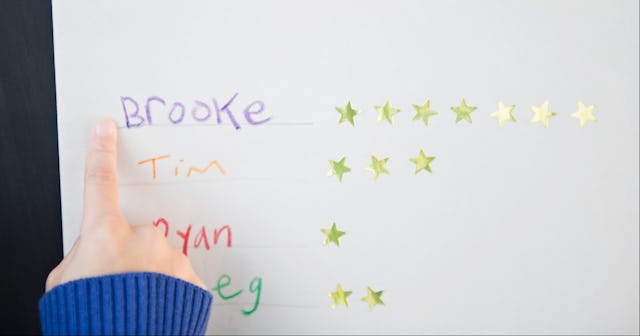Reward Chart For Kids: How To Make Good Behavior Stick Around

Little brains are so amazing, aren’t they? By the time your child is a 3-year-old, it’ll be practically impossible not to marvel every day over just how smart they are. And being smart at this age is more than just counting and knowing the alphabet — your child is also learning how to negotiate with you. Whether it’s with cuddle time or dessert, they’ve got an opinion. Of course, this also means that your little one can be very, very stubborn. Many tasks (like cleaning up, and remembering to go potty in time), they’ll toss aside in favor of playing. Plus, toddlers aren’t afraid to tell you no, which can be very frustrating as a parent. This is sort of a typical toddler flex as they learn to test boundaries! Fortunately, there are countless methods to use to try and fix this issue. One idea? A reward chart for kids to help keep them on task.
Having a toddler reward chart in the house will remind your child how far they are in their progress — and how much farther they have to go. If you’re looking to create a behavior chart at home for behavior management, here are some great methods to try out.
Reward Chart Ideas
Try Sticker Charts for Toddlers
Stickers are great for plenty of reasons. For one, they’re a visual reminder of achievement. Second, stickers are just fun to see on a reward chart. Kids are invested in seeing their amount of stickers rise. Unlike using food as a treat, this type of reward doesn’t create unhealthy associations. When thinking about behavior management and reward charts, it’s important to try to figure out what kind of kid you have. What makes them excited? If it’s stickers, this is a great place to start. There are also printable reward charts and reward chart systems that use dry erase markers. These are easy to find on Amazon with a quick search, so get your Prime on, Mama.
Let Your Child Take Charge
Your child shouldn’t lead the chore chart, but it’s important that they’re involved. Let them put the stickers on themselves, or ask them what kind of reward they’d like to work towards. If you involve your child from the very beginning, you’ll likely create a motivating award they can really stand behind, as they picked it themselves.
Celebrate Every Accomplishment
If they make small steps forward, that’s worth celebrating! Let your child know how close they are to the finish line. Setting reminders like “only three more stickers wins a prize” or “you’re one step away from your zoo trip” will remind them what’s at stake. Since children can often get distracted, it’s important to remind them of their progress and their goals. Make a big deal out of it — they’ll have a better understanding that what they did is good, and they’ll strive for that same happy reaction from you once again.
Ask Them Questions About What They’re Doing
Kids want to please their parents and share interests with them. That means that you should ask them about their progress, and talk to them about how it’s going if they’re verbally able to do so. If it’s a chore like washing their hands, ask your child if they can show you how it’s done next time. That will make it more of an enjoyable activity, as it’s one you share.
Always Be Positive
Kids are going to slip up. It happens. If something big changes — like, if you move, or if you’re unable to see relatives your kids absolutely love for a span of time (hello, social distancing!) — expect things to fall by the wayside a little bit. Don’t punish your child for setbacks. You know they’ll be able to get back to where they once were with some reinforcement. Try hard not to yell at your child for any slip-ups. It may discourage them or scare them away from trying again.
As a general rule of thumb, think back to your childhood. The people who probably had a positive influence on you were likely positive people. Be that person for your kid every day, but especially as they’re working towards a big milestone.
Reward Chart Ideas for the Classroom
When it comes to systematic child management, teachers have it down pat. Here are a few reward chart ideas straight from the classroom you can use at home!
- Grab a jar and draw three equidistant lines from top to bottom. Each one represents a privilege like eating snacks, going to the movies, or extra playtime. If the child talks back or is mean to their siblings, put a few beans in the jar. If they surpass a marking, they can’t partake in that activity.
- Give the kids play money and take away or give them more fake funds based on their actions throughout the week. And get creative, Mama. Model the money after their favorite characters or movies for a little extra incentive.
- Class coupons are similar to the play money idea, but these cutout creations can be exchanged for fun activities and privileges. Teachers can give out a “switch seats” coupon, which gives children the chance to sit next to their buddy. And for mamas, you can make “wear mommy’s sunglasses,” “extra screen time,” or “extra cupcake” coupons. Give these out to your kid if they do well in school or something sweet for their sibling. To keep track of the coupons, make a chart and put a star next to your child’s name for each coupon they earn. Then at the end of the week or month, see who earned the least and talk about what they can do to get more.
This article was originally published on